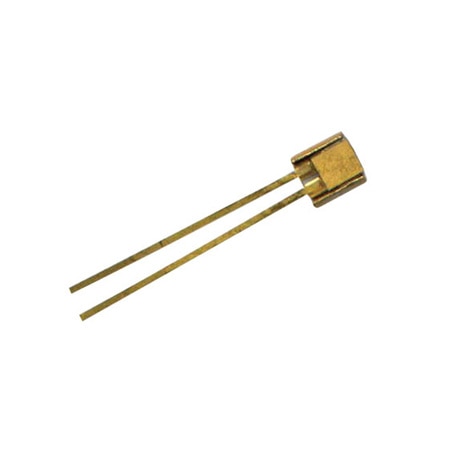1-800-663-4209 | Vos commentaires sont importants, répondez à un sondage rapide commentaires sur le site web

CY670
Cryogenic Silicon Diode Temperature Sensor
Modèles en stock
- Best Accuracy Across the Widest Useful Temperature Range, 1.4 to 500 K
- Tightest Tolerances for Applications from 30 to 500 K
- Rugged, Reliable SD Package (Designed to Withstand Repeated Thermal Cycling and Minimize Sensor Self-Heating)
- Conformance to Standard Curve CY670 (Temperature Response Curve Variety of Packaging Options)
CY670
Depuis
C$
908.33
Modèles en stock
L'aperçu du produit
- Current, Max Note 1 mA, continuous or 100 mA, pulsed
- Output Signal Voltage
- Process Temperature, Max 226.85 °C
- Process Temperature, Min -271.8 °C
- Recommended Excitation 10 µA, ± 0.1%
- Repeatability ± 10 mK @ 4.2 K
- Reverse Voltage 60 V
- Supply Power Effects 16 µW @ 4.2 K; 10 µW @ 77 K; 5 µW @ 300 K
- Temperature Sensor Type Silicon Diode
- Thermal Response Time SD Model: Typical <10 ms @; 4.2 K, 100 ms @ 77 K, 200 ms ;@ 305 K;BR Model: 1 ms @ 4.2 K, ;13 ms @ 77 K, 20 ms @ 305 K
- Use in Magnetic Field Note Not recommended for use in magnetic field applications below 60 K; low magnetic field dependence when used in fields up to 5 tesla above 60 K
- Use in Radiation Note Recommended for use only in low level radiation
The CY670 Series silicon diodes offer a more accurate reading of temperature ranges compared to previously marketed silicone diodes. Conforming to the curve CY670 standard voltage vs. temperature response curve, sensors within the CY670 Series are interchangeable, and for many applications they do not require individual calibration. CY670 Series sensors in the SD package are available in 5 tolerance bands–3 for general cryogenic use across the 1.4 to 500 K temperature range, and 1 that offers superior accuracy for applications from 30 K to room temperature. The CY670 Series sensors also come in a tolerance band (E), which is available only as a bare die. For applications requiring greater accuracy, CY670-SD diodes are available with calibration across the full 1.4 to 500 K temperature range.
The CY670E bare die sensor provides the smallest physical size and fastest thermal response time of any silicon diode on the market today. This is an important advantage for applications where size and thermal response time are critical, including focal plane arrays and high temperature superconducting filters for cellular communication.
SPECIFICATIONS
Standard Curve: Curve CY670, see chart next page
Recommended Excitation: 10 µA, ± 0.1%
Max Reverse Voltage: 60 V
Max Current Before Damage: 1 mA, continuous or 100 mA, pulsed
Dissipation at Recommended Excitation: 16 µW @ 4.2 K; 10 µW @ 77 K; 5 µW @ 300 K
Thermal Response Time: SD Model: Typical <10 ms @ 4.2 K, 100 ms @ 77 K, 200 ms @ 305 K
BR Model: 1 ms @ 4.2 K, 13 ms @ 77 K, 20 ms @ 305 K
Use in Radiation: Recommended for use only in low level radiation
Use in Magnetic Field: Not recommended for use in magnetic field applications below 60 K; low magnetic field dependence when used in fields up to 5 tesla above 60 K
Reproducibility(*): ± 10 mK @ 4.2 K
(*) Short-term reproducibility data is obtained by subjecting sensor to repeated thermal shocks from 305 to 4.2 K.
The CY670E bare die sensor provides the smallest physical size and fastest thermal response time of any silicon diode on the market today. This is an important advantage for applications where size and thermal response time are critical, including focal plane arrays and high temperature superconducting filters for cellular communication.
SPECIFICATIONS
Standard Curve: Curve CY670, see chart next page
Recommended Excitation: 10 µA, ± 0.1%
Max Reverse Voltage: 60 V
Max Current Before Damage: 1 mA, continuous or 100 mA, pulsed
Dissipation at Recommended Excitation: 16 µW @ 4.2 K; 10 µW @ 77 K; 5 µW @ 300 K
Thermal Response Time: SD Model: Typical <10 ms @ 4.2 K, 100 ms @ 77 K, 200 ms @ 305 K
BR Model: 1 ms @ 4.2 K, 13 ms @ 77 K, 20 ms @ 305 K
Use in Radiation: Recommended for use only in low level radiation
| Range of Use | Limit Min | Limit Max |
|---|---|---|
| CY670-SD | 1.4 K | 500 K |
| CY670E-BR | 1.4 K | 500 K |
Use in Magnetic Field: Not recommended for use in magnetic field applications below 60 K; low magnetic field dependence when used in fields up to 5 tesla above 60 K
Reproducibility(*): ± 10 mK @ 4.2 K
(*) Short-term reproducibility data is obtained by subjecting sensor to repeated thermal shocks from 305 to 4.2 K.
|
| |||||||||||||||||||||||||||||||||||||||
| ||||||||||||||||||||||||||||||||||||||||
Afficher les notes et les avis
what is the lifespan of this sensor?
Thank you for the inquiry. Long term stability can be used as a guide to service life. Long term stability specification is given in terms of thermal cycling. These details are given in the linked data sheet pdf file in this product page.
Best regards
OMEGA
Date published: 2024-12-06